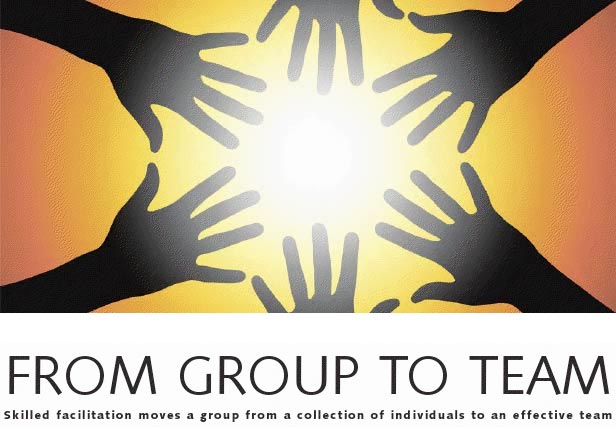
BY GINNY V. LEE
It is a Saturday morning, and I am sitting with a group of 15 new and aspiring school site administrators. As part of their work toward an MS in educational leadership, this group of experienced educators is enrolled in an elective course, "Group Facilitation for School Leaders." The 12 women and three men are all experienced K-12 teachers. Collectively, they have led and served on numerous committees and work groups at their sites and in their districts.
We are discussing the concept of teams and communities in school settings. I ask the group, "In your view, what is the difference between a group and a team?" They think for a minute. How IS a team different from a group? They toss around some ideas: Is one made up of volunteers and the other not? Does one have a formal affiliation and the other not? As they postulate and discard ideas, their thinking becomes clearer, and they decide that the most important ways that a team differs from a group are these:
Groups, for example, may consist of people who share a role and responsibilities that provide an opportunity for the group to evolve to a team (for example, 4th-grade teachers, English department members), but this evolution does not always occur (Killion, 2006).
When I ask the group how many of them have been part of a high-functioning, effective team at their site or in their district, two people raise their hands. Most are shaking their heads as they realize how little experience they have with effective teamwork. They cite instances of contrived collegiality (Hargreaves & Dawe, 1990) and working on joint tasks in the most expeditious way possible, pushing hastily through challenging discussions, arriving at decisions on the fly, and focusing on getting the work done. At this point, I present concepts and strategies that support facilitators in understanding and addressing key issues that emerge during the initial stages of team development.
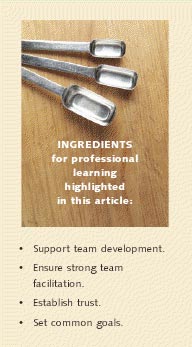 TEACHER COLLABORATION: PROMISES AND PITFALLS
TEACHER COLLABORATION: PROMISES AND PITFALLS
Since the publication of Little's 1982 study, "Norms of collegiality and experimentation: Workplace conditions of school success," educators have compiled a considerable body of knowledge around the importance of teacher collaboration as a component of professional learning (Eaker, DuFour, & DuFour, 2002; Lieberman, 1996; Speck & Knipe, 2001). We see the concept of collaboration embedded in the concept of professional learning communities as well as in NSDC's Standards for Staff Development (NSDC, 2001). As districts and schools embrace the promise of collaboration to support teachers in honing practice, educators have become increasingly adept at developing structures and processes that establish regular opportunities for teachers to come together and engage in meaningful professional dialogue focused on student learning.
In many ways, our understanding of teacher collaboration for professional learning parallels a body of work on team development and performance.
Despite the plethora of examples, strategies, formats, protocols, and promise, the transition from a group to a collaborative team is not always smooth or effective. Given the norms of autonomy and private practice that have informed teaching for so many decades (Little, 1982), this is not surprising. Nevertheless, many efforts to support teachers in moving from being participants of groups to being members of collaborative teams miss the mark by overlooking stages in team development that can make or break the process.
In my experience working directly with collaborative groups and listening to my students describe their experiences, I have come to identify a number of false assumptions that educators often make about such work: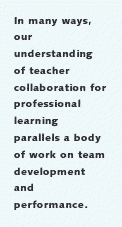 While the strategies in the list above contain some useful ideas
for supporting team or community development, these ideas oversimplify and trivialize the
issues that members bring to a team. Such Band-Aid solutions might establish a surface of
civility among group members, but they will not suffice to support the kind of deep
connection (with each other and with the team's purpose) and trust that enable teams to
soar.
While the strategies in the list above contain some useful ideas
for supporting team or community development, these ideas oversimplify and trivialize the
issues that members bring to a team. Such Band-Aid solutions might establish a surface of
civility among group members, but they will not suffice to support the kind of deep
connection (with each other and with the team's purpose) and trust that enable teams to
soar.
As I listen to students discuss negative colleagues, individuals who don't understand why collaboration is good idea or who take a "been there, done that" attitude, I am touched by the depth of their frustration and their belief in the potential benefits to be gained. What I see missing for them is a deep understanding of the questions and issues that team members naturally bring with them to a team and a lack of authentic tools with which to address these matters.
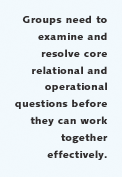 MODELS OF TEAM DEVELOPMENT
MODELS OF TEAM DEVELOPMENT
One of the best-known theories of team development is captured in Tuckman's model of groups going through the predictable stages of "forming, storming, norming, and performing" (Tuckman, 1965). This model acknowledges the inevitable clash of assumptions, beliefs, perspectives, goals, and values that individuals bring with them to any group endeavor. The model recognizes the need for groups to engage in examining and resolving core relational and operational questions before they can be expected to work together effectively.
For a facilitator to support the process of a team advancing from the forming to the performing stage, he or she must understand the core issues that typically arise for team participants at each stage and realize what happens to a team when the issues are not satisfactorily resolved. Moreover, the facilitator must be able to recognize signs that individuals or subgroups have not resolved one or more of these questions and must be able to intervene appropriately. All too often, team facilitators are limited in their capacity to engage the deep issues and rely on the set of tools described above under false assumptions: overuse of icebreakers; appealing to the "professionalism" of the individuals; expecting norms to resolve differences; and depending on clear structures, agendas, protocols, and activities to counterbalance underlying dissatisfactions.
 One of the most useful tools that my students and I have used to support our work in
facilitating teams is the Team Performance Model developed by Drexler, Sibbet, and Forrester
(2009). In this model, the developers identify seven stages that describe a team's evolution
from formation through task completion and renewal.
One of the most useful tools that my students and I have used to support our work in
facilitating teams is the Team Performance Model developed by Drexler, Sibbet, and Forrester
(2009). In this model, the developers identify seven stages that describe a team's evolution
from formation through task completion and renewal.
With respect to the issues identified in this article, the first two stages of the Team Performance Model are especially relevant. In the remainder of this piece, I describe these stages with a focus on what happens when issues are unresolved for team members. Following each of these descriptions are suggestions for facilitators.
MOVING FROM GROUP TO TEAM
Stage 1: Orientation.
In the orientation stage, team members are coming together to learn about the project or initiative that it will undertake. Typically, members do not have work history with everyone on the team and may not even be sure what the project is about. In this stage, the primary concern of the members is, "Why am I here?" The emphasis at this stage is on both the team's purpose as well as the "I" part of the question: Why was this team formed, and why was I included? Assuming that the team's purpose is made clear, members ponder whether and how they fit the group and the purpose. If a group member is not satisfied that she or he has a place on the team, the likely response, according to Drexler et al., is disorientation, uncertainty, and fear. Consider the following description:
Nominal members who are misfits lacking any purposeful way to relate to others are disconnected from the group. They tend to focus on this lack of connection, making others feel uncomfortable. The internal conflict experienced by these marginal persons expresses itself in various dysfunctional ways. They may become withdrawn or distant from the group, or offer unsolicited criticism, never finding much value in the team's work (Drexler et al., 2009, p. 8).
When the orientation stage is resolved, the group is on its way to becoming a team. Members begin thinking in terms of "us," they identify with the purpose, and they begin to imagine what the team could achieve.
For the facilitator, achieving resolution at this stage involves:
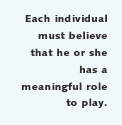 Stage 2: Trust building.
Stage 2: Trust building.
Virtually every facilitator understands that trust is a necessary ingredient for team performance. Because teams are interdependent, members must be able to relinquish full control and rely on others. If we stop to think about the people in our lives whom we trust, we quickly realize that such trust is developed experientially over time, through a deepening knowledge of the other person. To some extent, then, the development of trust is part and parcel of teams' ongoing work.
At the beginning stages of team development, the issue of trust can be captured by the question, "Who are you?" Without some resolution of this question, a lack of trust can translate into team members being cautious with each other, perhaps maintaining a façade, and not being forthright. When mistrust results in members not feeling free to speak their truth, the dynamics of the group are shaped by hidden agendas, unwillingness to voice issues of importance, and lack of integrity. All of these will impede both the authenticity of the work and the level of cooperation and collaboration among team members.
Resolving the trust-building stage requires that facilitators:
CONCLUSION
School-based learning depends on teachers' capacity to engage with each other around central issues of teaching and learning. While such collaboation is readily welcomed by some educators, others remain wedded to an "independent contractor" concept of teaching. Supporting teachers to view themselves as team members and to perform effectively as a team demands more of leaders than simply establishing structures and identifying tasks. Even assuming positive intent on the part of the participants, the journey from a group to a team can be daunting. Without skillful facilitation, groups are likely to encounterpersonal dynamics that not only provide unanticipated challenges but may also serve as deal breakers in becoming a high-performing team. An experienced, astute facilitator who models interpersonal skills and dispositions needed for effective team work can make the difference between a group that remains a collectivity of individuals and one that forges the bonds of cohesiveness and trust that allow great things to happen.
GINNY V. LEE (ginny.lee@csueastbay.edu) is associate professor of educational leadership at California State University East Bay.
REFERENCES
Drexler, A., Sibbet, D., & Forrester, R. (2009).
The team performance model. San Francisco: The Grove Consultants.
Eaker, R., DuFour, R., & DuFour, R. (2002).
Getting started: Reculturing schools to become professional learning communities. Bloomington, IN: Solution Tree.
Hargreaves, A. & Dawe, R. (1990).
Paths of professional development: Contrived collegiality, collaborative culture, and the case of peer coaching. Teaching and Teacher Education, 6(3), 227-241.
Kaner, S., Lind, J., Toldi, C., Fisk, S., & Berger, D. (2007).
Facilitator's guide to participatory decision-making (2nd ed.). San Francisco: Jossey-Bass.
Killion, J. (2006, April).
Teacher meetings do not make a community. Teachers Teaching Teachers, 1(7), pp. 6-7.
Lieberman, A. (1996, November).
Creating intentional learning communities. Educational Leadership, 54(3), 51-55.
Little, J.W. (1982, Fall).
Norms of collegiality and experimentation: Workplace conditions of school success. American Educational Research Journal, 19(3), 325-340.
National Staff Development Council. (2001).
NSDC's standards for staff development. Oxford, OH: Author.
Speck, M. & Knipe, C. (2001).
Why can't we get it right? Professional development in our schools. Thousand Oaks, CA: Corwin Press.
Tuckman, B.W. (1965).
Developmental sequences in small groups. Psychological Bulletin, 63(6), 384-399.
- National Staff Development Council's Journal of Staff Development (December 2009)
It is a Saturday morning, and I am sitting with a group of 15 new and aspiring school site administrators. As part of their work toward an MS in educational leadership, this group of experienced educators is enrolled in an elective course, "Group Facilitation for School Leaders." The 12 women and three men are all experienced K-12 teachers. Collectively, they have led and served on numerous committees and work groups at their sites and in their districts.
We are discussing the concept of teams and communities in school settings. I ask the group, "In your view, what is the difference between a group and a team?" They think for a minute. How IS a team different from a group? They toss around some ideas: Is one made up of volunteers and the other not? Does one have a formal affiliation and the other not? As they postulate and discard ideas, their thinking becomes clearer, and they decide that the most important ways that a team differs from a group are these:
- Teams share a common purpose and goal.
- Team members are interdependent; they understand that they need to work well as a unit in order to complete their task.
Groups, for example, may consist of people who share a role and responsibilities that provide an opportunity for the group to evolve to a team (for example, 4th-grade teachers, English department members), but this evolution does not always occur (Killion, 2006).
When I ask the group how many of them have been part of a high-functioning, effective team at their site or in their district, two people raise their hands. Most are shaking their heads as they realize how little experience they have with effective teamwork. They cite instances of contrived collegiality (Hargreaves & Dawe, 1990) and working on joint tasks in the most expeditious way possible, pushing hastily through challenging discussions, arriving at decisions on the fly, and focusing on getting the work done. At this point, I present concepts and strategies that support facilitators in understanding and addressing key issues that emerge during the initial stages of team development.
 TEACHER COLLABORATION: PROMISES AND PITFALLS
TEACHER COLLABORATION: PROMISES AND PITFALLSSince the publication of Little's 1982 study, "Norms of collegiality and experimentation: Workplace conditions of school success," educators have compiled a considerable body of knowledge around the importance of teacher collaboration as a component of professional learning (Eaker, DuFour, & DuFour, 2002; Lieberman, 1996; Speck & Knipe, 2001). We see the concept of collaboration embedded in the concept of professional learning communities as well as in NSDC's Standards for Staff Development (NSDC, 2001). As districts and schools embrace the promise of collaboration to support teachers in honing practice, educators have become increasingly adept at developing structures and processes that establish regular opportunities for teachers to come together and engage in meaningful professional dialogue focused on student learning.
In many ways, our understanding of teacher collaboration for professional learning parallels a body of work on team development and performance.
Despite the plethora of examples, strategies, formats, protocols, and promise, the transition from a group to a collaborative team is not always smooth or effective. Given the norms of autonomy and private practice that have informed teaching for so many decades (Little, 1982), this is not surprising. Nevertheless, many efforts to support teachers in moving from being participants of groups to being members of collaborative teams miss the mark by overlooking stages in team development that can make or break the process.
In my experience working directly with collaborative groups and listening to my students describe their experiences, I have come to identify a number of false assumptions that educators often make about such work:
- If group members don't know each other well, a series of ice-breakers will bring them together.
- A group of educators knows how to engage with each other as professionals.
- If the facilitator of the group is unsure about the group's capacity to engage professionally, developing a set of norms will resolve this issue.
- Being clear with a group about tasks, structure, and accountability will lead to quality group output.
 While the strategies in the list above contain some useful ideas
for supporting team or community development, these ideas oversimplify and trivialize the
issues that members bring to a team. Such Band-Aid solutions might establish a surface of
civility among group members, but they will not suffice to support the kind of deep
connection (with each other and with the team's purpose) and trust that enable teams to
soar.
While the strategies in the list above contain some useful ideas
for supporting team or community development, these ideas oversimplify and trivialize the
issues that members bring to a team. Such Band-Aid solutions might establish a surface of
civility among group members, but they will not suffice to support the kind of deep
connection (with each other and with the team's purpose) and trust that enable teams to
soar.As I listen to students discuss negative colleagues, individuals who don't understand why collaboration is good idea or who take a "been there, done that" attitude, I am touched by the depth of their frustration and their belief in the potential benefits to be gained. What I see missing for them is a deep understanding of the questions and issues that team members naturally bring with them to a team and a lack of authentic tools with which to address these matters.
 MODELS OF TEAM DEVELOPMENT
MODELS OF TEAM DEVELOPMENTOne of the best-known theories of team development is captured in Tuckman's model of groups going through the predictable stages of "forming, storming, norming, and performing" (Tuckman, 1965). This model acknowledges the inevitable clash of assumptions, beliefs, perspectives, goals, and values that individuals bring with them to any group endeavor. The model recognizes the need for groups to engage in examining and resolving core relational and operational questions before they can be expected to work together effectively.
For a facilitator to support the process of a team advancing from the forming to the performing stage, he or she must understand the core issues that typically arise for team participants at each stage and realize what happens to a team when the issues are not satisfactorily resolved. Moreover, the facilitator must be able to recognize signs that individuals or subgroups have not resolved one or more of these questions and must be able to intervene appropriately. All too often, team facilitators are limited in their capacity to engage the deep issues and rely on the set of tools described above under false assumptions: overuse of icebreakers; appealing to the "professionalism" of the individuals; expecting norms to resolve differences; and depending on clear structures, agendas, protocols, and activities to counterbalance underlying dissatisfactions.
 One of the most useful tools that my students and I have used to support our work in
facilitating teams is the Team Performance Model developed by Drexler, Sibbet, and Forrester
(2009). In this model, the developers identify seven stages that describe a team's evolution
from formation through task completion and renewal.
One of the most useful tools that my students and I have used to support our work in
facilitating teams is the Team Performance Model developed by Drexler, Sibbet, and Forrester
(2009). In this model, the developers identify seven stages that describe a team's evolution
from formation through task completion and renewal.With respect to the issues identified in this article, the first two stages of the Team Performance Model are especially relevant. In the remainder of this piece, I describe these stages with a focus on what happens when issues are unresolved for team members. Following each of these descriptions are suggestions for facilitators.
MOVING FROM GROUP TO TEAM
Stage 1: Orientation.
In the orientation stage, team members are coming together to learn about the project or initiative that it will undertake. Typically, members do not have work history with everyone on the team and may not even be sure what the project is about. In this stage, the primary concern of the members is, "Why am I here?" The emphasis at this stage is on both the team's purpose as well as the "I" part of the question: Why was this team formed, and why was I included? Assuming that the team's purpose is made clear, members ponder whether and how they fit the group and the purpose. If a group member is not satisfied that she or he has a place on the team, the likely response, according to Drexler et al., is disorientation, uncertainty, and fear. Consider the following description:
Nominal members who are misfits lacking any purposeful way to relate to others are disconnected from the group. They tend to focus on this lack of connection, making others feel uncomfortable. The internal conflict experienced by these marginal persons expresses itself in various dysfunctional ways. They may become withdrawn or distant from the group, or offer unsolicited criticism, never finding much value in the team's work (Drexler et al., 2009, p. 8).
When the orientation stage is resolved, the group is on its way to becoming a team. Members begin thinking in terms of "us," they identify with the purpose, and they begin to imagine what the team could achieve.
For the facilitator, achieving resolution at this stage involves:
- Making explicit the team's purpose and the reasons behind the membership. An essential piece of explicating purpose is doing so without articulating an overly specific goal. "We are here to discuss ways that we can improve reading comprehension for our second language learners" will work much better than, "We are here to analyze comprehension data for our second language learners and design specific interventions consistent with adopted texts." The key is to allow the team to arrive at specific goals that address the purpose.
- Engaging individuals in articulating what essential knowledge, skills, history, etc., that each brings to the team. To share in the purpose of a team effort, each individual must believe that he or she has a meaningful role to play. Prompting members to identify what they believe are relevant knowledge, skills, and experience and then to surface the strengths and unique perspectives of each individual helps create the conection to purpose and the sense that "I belong here."
- Supporting individuals in imagining the power of "we," helping members envision possibility and shared purpose. The power of teams resides in the synergy of the collective. Thus, involving individuals at the orientation stage in tapping into their individual and collective ideas about what is possible, imagining what success would look like, and exploring outside-the-box choices can create both enthusiasm and commitment to the future of the team.
 Stage 2: Trust building.
Stage 2: Trust building.Virtually every facilitator understands that trust is a necessary ingredient for team performance. Because teams are interdependent, members must be able to relinquish full control and rely on others. If we stop to think about the people in our lives whom we trust, we quickly realize that such trust is developed experientially over time, through a deepening knowledge of the other person. To some extent, then, the development of trust is part and parcel of teams' ongoing work.
At the beginning stages of team development, the issue of trust can be captured by the question, "Who are you?" Without some resolution of this question, a lack of trust can translate into team members being cautious with each other, perhaps maintaining a façade, and not being forthright. When mistrust results in members not feeling free to speak their truth, the dynamics of the group are shaped by hidden agendas, unwillingness to voice issues of importance, and lack of integrity. All of these will impede both the authenticity of the work and the level of cooperation and collaboration among team members.
Resolving the trust-building stage requires that facilitators:
- Model forthrightness, honesty, and integrity; be completely trustworthy themselves. Essential to this stance are the concepts of transparency and forthrightness. Team members must be assured that the process is an open one and that any constraints, boundaries, or limitations are stated at the beginning of the work. Rather than keeping team members from dreaming, for example, presenting clear information about matters such as resources, timelines, expectations, and accountability help set parameters for the effort and convey the respect of the facilitator for the team's capacity to work effectively under current circumstances. Similarly, team members must be assured that the facilitator is not doling out information selectively.
- Create a safe environment for self-revelation; protect unpopular opinions; champion the marginalized. Skilled facilitators are able to engage team members in increasingly courageous conversation. Neutrality is essential here, as is a willingness to ensure that the voice of each member receives equitable attention, respect, and consideration. It is especially important not to dismiss the voice of a lone individual whose thinking differs from the rest of the group. Rather, the facilitator wants to support that individual in articulating ideas, to check that others in the group understand the person's reasoning and/or feelings, and to make sure that the group does not move forward with an option that is unacceptable to anyone. (Note: This means avoiding votes and majority rule as a decision-making strategy. See Kaner, Lind, Toldi, Fisk, & Berger's Facilitator's Guide to Participatory Decision-Making (2007) for specific ideas about negotiating decisions.)
- Engage participants in learning more about each other's history, perspective, needs, individual priorities, and work styles. One of the most insidious challenges to trust is the situation in which individuals make assumptions about others: "She's African-American, so she must know best how to work with our African-American students"; "He teaches P.E., so he must not understand the importance of academic standards"; "She's been in charge of grant oversight for the past five years, so she must have answers for us." At best, such assumptions cause misunderstandings and perhaps some embarrassment that could be avoided by asking rather than assuming. At worst, such assumptions represent biases, prejudices, and intolerance that poison the possibility of trust.
CONCLUSION
School-based learning depends on teachers' capacity to engage with each other around central issues of teaching and learning. While such collaboation is readily welcomed by some educators, others remain wedded to an "independent contractor" concept of teaching. Supporting teachers to view themselves as team members and to perform effectively as a team demands more of leaders than simply establishing structures and identifying tasks. Even assuming positive intent on the part of the participants, the journey from a group to a team can be daunting. Without skillful facilitation, groups are likely to encounterpersonal dynamics that not only provide unanticipated challenges but may also serve as deal breakers in becoming a high-performing team. An experienced, astute facilitator who models interpersonal skills and dispositions needed for effective team work can make the difference between a group that remains a collectivity of individuals and one that forges the bonds of cohesiveness and trust that allow great things to happen.
GINNY V. LEE (ginny.lee@csueastbay.edu) is associate professor of educational leadership at California State University East Bay.
REFERENCES
Drexler, A., Sibbet, D., & Forrester, R. (2009).
The team performance model. San Francisco: The Grove Consultants.
Eaker, R., DuFour, R., & DuFour, R. (2002).
Getting started: Reculturing schools to become professional learning communities. Bloomington, IN: Solution Tree.
Hargreaves, A. & Dawe, R. (1990).
Paths of professional development: Contrived collegiality, collaborative culture, and the case of peer coaching. Teaching and Teacher Education, 6(3), 227-241.
Kaner, S., Lind, J., Toldi, C., Fisk, S., & Berger, D. (2007).
Facilitator's guide to participatory decision-making (2nd ed.). San Francisco: Jossey-Bass.
Killion, J. (2006, April).
Teacher meetings do not make a community. Teachers Teaching Teachers, 1(7), pp. 6-7.
Lieberman, A. (1996, November).
Creating intentional learning communities. Educational Leadership, 54(3), 51-55.
Little, J.W. (1982, Fall).
Norms of collegiality and experimentation: Workplace conditions of school success. American Educational Research Journal, 19(3), 325-340.
National Staff Development Council. (2001).
NSDC's standards for staff development. Oxford, OH: Author.
Speck, M. & Knipe, C. (2001).
Why can't we get it right? Professional development in our schools. Thousand Oaks, CA: Corwin Press.
Tuckman, B.W. (1965).
Developmental sequences in small groups. Psychological Bulletin, 63(6), 384-399.
- National Staff Development Council's Journal of Staff Development (December 2009)